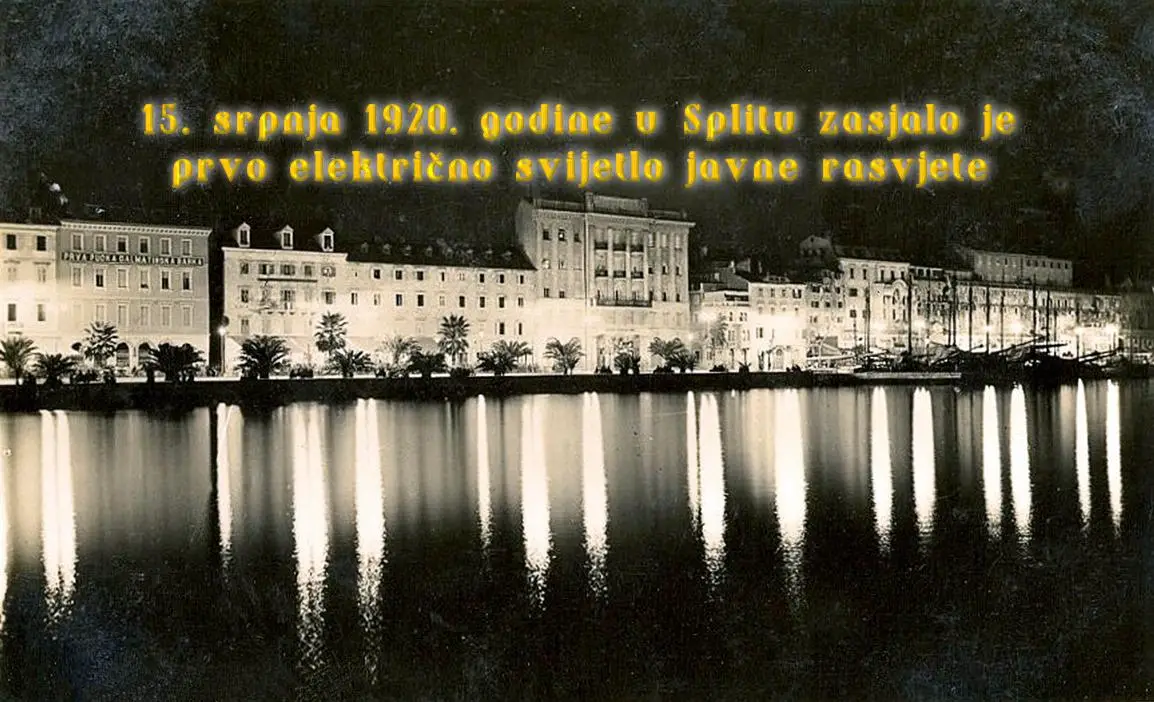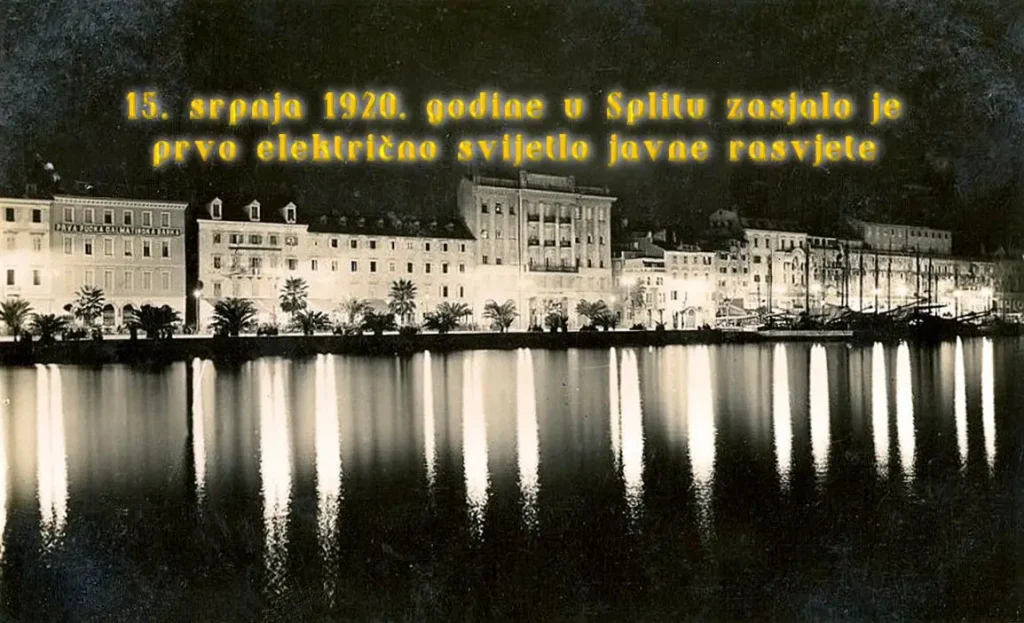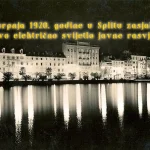
July 20, 2020 – July 12 marks one hundred years since the first electric public lighting shone in Split, on the famous Riva.
Unfortunately, few have recognized the importance of this significant event in the history of the city, which often goes forgotten, reports Slobodna Dalmacija.
No symbolic monument was erected, nor is there a memorial plaque at the first transformer station in Manuska Poljana. However, thanks to the Collegium Split Association, which has documented the city’s history for more than two years, two videos have been made, giving a detailed overview of electrification in which preceded it, as well as a list of the most important power facilities erected from 1920 to 2020.
“This paper on the history of electrification in Split factually, and primarily technically shows the development of a branch that influenced and changed the means of work and way of life of the city. Further study will determine the consequences of this technological change,” said Mladen Jelic, one of the leaders of Collegium Split.
Jelic adds that the application of electricity, compared to other European cities, was very slow. The main block was the unfavorable economic conditions in our region, especially in the time of Austro-Hungary. The Ministry in Vienne issued permits for the construction of electrical appliances, and only when the venture did not conflict with Austrian interests and outdated legislation.
The first public lighting of the city came with the French and Marshal Marmont in 1808, who, in agreement with Vincenzo Dandol, installed 81 lanterns with oil lighting in Split. Lanterns were placed on street corners, and the maintenance of lighting depended on the proceeds from the sale of meat. As sales were weak at the time, there was generally no street lighting. In 1850, oil lanterns were replaced by kerosene lanterns.
After the water from the source of the Jadro was brought to Split in 1879, with the restoration of Diocletian’s aqueduct, the citizens realized more and more clearly that from the source of this river, the city could get not only water but also power and light, the most important elements for development and progress.
“In 1882, the People’s Party, which advocated the unification of Dalmatia with Croatia, won the elections and then won the Municipality of Split. The industrial development of the city begins and Split grew from 15 to 25 thousand inhabitants, as recorded in 1921. In 1886, the municipal administration discussed the construction of a hydroelectric power plant in Majdan on the Jadro river, but the municipal government did not have sufficient funds to build the power plant. When the company “Split AD” built the hydroelectric power plant “Vrilo” for the needs of its cement factory in Majdan in 1908, a dispute arose between the municipality of Split and the company, which ended in a settlement in 1914.
The settlement gave Split the right to uninterrupted use of 75 kW. Namely, from 1898 on the supply of electricity, as the people of Split called it, there was a fierce struggle in the municipal council. The interests of the city did not win in 1908 because the government gave Mato Vidovic an unlimited concession for the use of hydropower at the source of the Jadro. The municipality was only left with the right to water for the needs of the city water supply, but not for electricity,” Jelic said.
So, in 1908, the Vrilo hydroelectric power plant was built at the very source of the Jadro river. It was the first power plant in the area of Split, owned by the Split engineer Emil Stock. In the same year, the people of Split had the opportunity to see the first electric light from several light bulbs in front of the Josip Karaman cinema, which was powered by a generator.
Four years later, the first stage of the Kraljevac hydroelectric power plant was completed, so the Municipality of Split held talks with the company “Sufid” on the possibility of building a transmission line from Dugi Rat to Split. The planned signing of the treaty was agreed for September 1914, but was not realized because of the First World War.
After the end of the war, in 1919, city councilors decided that Split must be given electric lighting. The gasworks, which had existed since 1862, did not operate immediately after the First World War due to a lack of coal, and thus no gas public lighting. The streets were dimly lit by acetylene lamps. In this difficult situation, the contract from 1914, which the municipality had with the cement factory Split, helped, according to which they were obliged to make 100 hp of electricity from the Jadro spring available to the city free of charge.
The City of Split then signed an agreement with the Czech company “Elektra – Prague” on a joint venture and the establishment of a limited liability company “Elektra”. The construction of the first, seven-kilometer-long 10 kV line from Majdan to Split, more precisely Manuska poljana, begun. At the beginning of January, the company “Elektricno poduzece d.so.j. Split” was registered, and the first director was engineer Jerko Jeric.
Mayor Ivo Tartaglia then addressed the citizens through whose terrains the power lines will pass with a request to enable uninterrupted work on the installation of the plant. Finally, on March 3, 1920, the first six-meter-high lighting pole was placed on a concrete pedestal near the Harbor Master’s Office, Jelic recounts the events from one of the most exciting years of the 20th century in Split.
Big changes were announced by the Culic brothers, the owners of the cinema on Boticeva poljana, who installed a DC generator for their needs. The Sokolsko drustvo on Tonciceva Street took the surplus electricity from them since April 2, and in mid-May, one light bulb illuminated Boticeva poljana, i.e., Prokurative. On May 5, the Uzezin of St. Duje was lit by several electric poles on the waterfront, connected to the generator, in order to evoke the long-awaited lighting for the people of Split. Only once before did the citizens experience something similar – on October 26, 1913, at Peristyle, illuminated by electricity from the generator, a stage performance of the solemn epilogue “Death of Emperor Diocletian” by Milan Ogrizovic was performed, all thanks to Don Fran Bulic.
Finally, a 10 kV transmission line, 6.5 km long on wooden poles from Majdan to the first transformer station on Manuska Poljana, transmitted electricity. It was a big event.
The daily newspaper “Novo doba” warned citizens that it is strictly forbidden to touch the wires of electric lines because they are life-threatening; it is forbidden to hang laundry, flags and throw any objects over electric wires, as well as repair roofs.
And so, to the great delight of the citizens, the electric public lighting on the Split waterfront shone for the first time on July 12, of course, with limited lighting of 12 kW. By the end of the month, Maruliceva and Bosanska, Pjaca, Sinjska and Matosiceva streets, Arnirova and Boticeva poljana, Nodilova street, and Veli Varos were illuminated, and gradually electricity began to be introduced into private apartments. In August 1920, the Troccoli cafe was illuminated.
Just how much this meant to citizens is depicted in an article from “Novo doba” which reads as follows:
“… no one thinks of yesterday’s darkness, but sees in front of him Veli Split, from Omis to Trogir, illuminated by electric light, crossed by electric trams and railways, surrounded by lively ports and rich factories.”
To read more about lifestyle in Croatia, follow TCN’s dedicated page.










